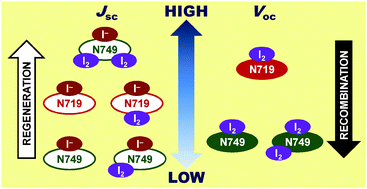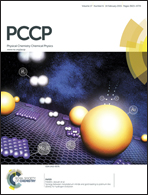A comparative computational study on the interactions of N719 and N749 dyes with iodine in dye-sensitized solar cells†
Abstract
The intermolecular interactions of the two most basic Ru(II) complex dyes for dye-sensitized solar cells (DSSCs), N719 and N749, with the iodine species are investigated using density functional theory (DFT). In addition to interactions with a single I2 molecule, multiple I2 interactions and simultaneous interactions of I2 and I− occur. N719 with two isothiocyanato (NCS) ligands interacts with two I2 molecules via the two terminal S atoms in the ground singlet electronic state, whereas N749 with three NCS ligands forms three S⋯I–I bonds. Irrespective of the NCS position and the number of I2 molecules, N749 has a stronger interaction with I2 than N719. Conversely, the interaction of I− with oxidized N749 via the terminal S atom of the NCS ligand is weaker than that with oxidized N719. However, simultaneous interactions of oxidized N749 with two I2 molecules promote the I− interaction, and the I− interaction with N749 becomes stronger than that with N719 bonded to both an I2 and I−. The computational results of multiple interactions between the dye and iodine species suggest that the difference in DSSC performance between N719 and N749 dyes is explained by recombination related to the I2 interaction and regeneration of the oxidized dye by I−.


 Please wait while we load your content...
Please wait while we load your content...